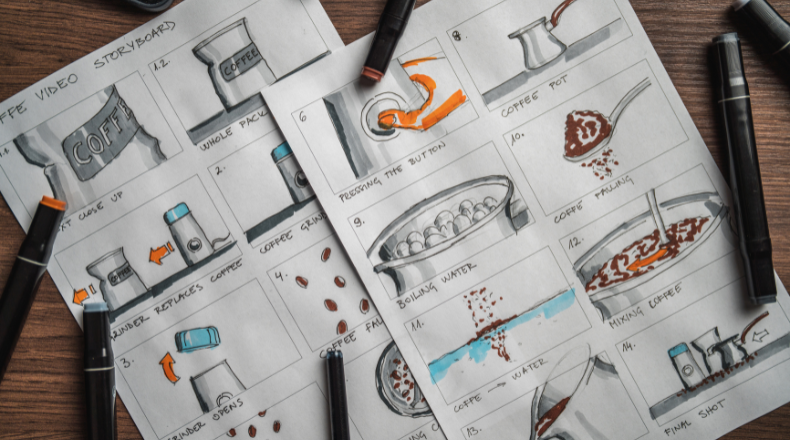Introduction
Animation is a magical medium that leaves stories alive and brings them to life for an audience
of all ages. A successful animation has a storyboard — a crucial blueprint — behind it guiding
the entire creative process. Since animators need to create a lot of scenes to represent a
thought process, storyboards are used to visualize the scenes, ensure the narrative is flowing and
the shots are planned. If you are an aspiring animator or an experienced animator, you can take
your projects from good to stunning by acquiring several storyboard techniques. In
this blog, we’re going to discuss essential storyboard ideas to make your animations better and
your workflow smoother.
Table of Contents
1. What is Storyboarding in Animation?
2. Importance of Storyboarding for Animators
3. Key Elements of a Great Storyboard
4. Creative Storyboard Ideas for Different Animation Styles
5. Tools and Software for Storyboarding in Animation
6. Tips to Create Effective Storyboards
7. Conclusion: Bringing Your Vision to Life
1. What is Storyboarding in Animation?
A storyboard is a visual outline of what your animation will be. Sequential drawings which are the scene
representation, along with the dialogue, action, and camera angles fit into it. These sketches serve as a
guide to how you want the story to play out—before you begin production. It’s important that
storyboards can be used to align the creative vision with the technical execution.
2. Importance of Storyboarding for Animators
Storyboarding offers numerous benefits, including:
- Visual Clarity: It gives you the visual of how scenes will play out.
- Improved Planning: It saves time by resolving potential things early.
- Team Collaboration: Makes sure everyone on the project has a grasp of the vision.
- Cost Efficiency: It reduces errors and revisions during production that need 't occur.
- Enhanced Creativity: Offers the possibility of exploring ideas creatively with little risk.
3. Key Elements of a Great Storyboard
To create a compelling storyboard, include these essential elements:
- Characters: Make sure the emotions and actions of your characters are represented.
- Backgrounds: Set the scene and give context with some basic details.
- Camera Movements: Make it like you are indicating zooms, pans, and other movements.
- Transitions: Show the continuity of one scene to the next.
- Dialogue and Notes: Provide text to explain what action, mood, etc this dialogue or action
should have.
4. Creative Storyboard Ideas for Different Animation Styles
A. 2D Animation Dynamic Angles:
- Try exciting movie angles with the camera to make it more interesting.
- Exaggerated Expressions: Classic 2D charm: Showline character emotions.
B. 3D Animation Depth of Field:
- Applying layers and perspective to make immersive scenes.
- Action Sequences: Make complex movements clear frames.
C. Stop-Motion Animation Frame-by-Frame Detail:
- Everything you do down to the micro aspect is micromanaged.
- Lighting Cues: Discuss the ways you would indicate lighting changes to alter mood.=
D. Animated Shorts Minimalist Approach:
- Make it concise while focusing on key elements.
- Creative Transitions: Try doing it differently with unique scene changes.
5. Tools and Software for Storyboarding in Animation
Here are some popular tools to simplify the storyboarding process:
- Toon Boom Storyboard Pro: An advanced feature-rich professional tool.
- Adobe Photoshop: Great for creating detailed sketches.
- Storyboarder by Wonder Unit: For beginners, free and user-friendly.
- Procreate: Perfect for storyboard creation on a tablet.
- Pencil2D: Very useful for lightweight 2D animation projects.
6. Tips to Create Effective Storyboards
- Start with a Script: The foundation is a well-written script.
- Keep it Simple: To start, concentrate more on being clear than on being detailed.
- Think Cinematically: Camera angles and movements are sed to tell stories more.
- Be Consistent: Keep characters and settings to the same typeface and size.
- Test Your Storyboard: See how it flows in motion with an animatic
Conclusion: Bringing Your Vision to Life
Stunning animations are a backbone created by storyboarding. Planned carefully, scenes visualized, and
collaborative work done right, you can imagine and take your animated masterpiece from creative vision
to captivating. Investing time in storyboarding your film whether it’s a short film or a feature-length
feature is going to help you get through the project with less stress and a cleaner result. Take a
sketchbook and start working or grab your favorite storyboarding tool, it is the world of animation.

